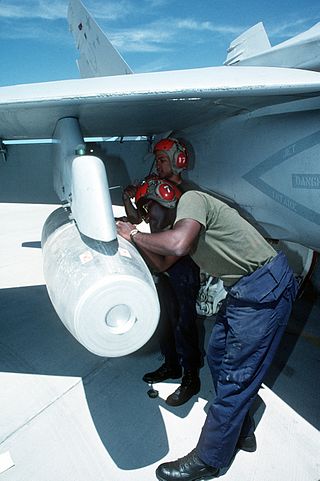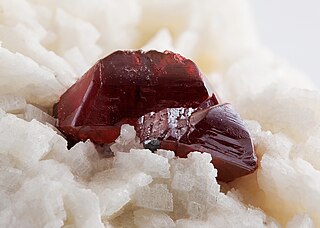
Mustard gas or sulfur mustard is any of several chemical compounds that contain the chemical structure SCH2CH2Cl. In the wider sense, compounds with the substituent SCH2CH2X and NCH2CH2X are known as sulfur mustards and nitrogen mustards, respectively, (where X = Cl or Br). Such compounds are potent alkylating agents, which can interfere with several biological processes. Also known as mustard agents, this family of compounds are infamous cytotoxic and blister agents with a long history of use as chemical weapons. The name mustard gas is technically incorrect: the substances, when dispersed, are often not gases but a fine mist of liquid droplets. Sulfur mustards are viscous liquids at room temperature and have an odor resembling mustard plants, garlic, or horseradish, hence the name. When pure, they are colorless, but when used in impure forms, such as in warfare, they are usually yellow-brown. Mustard gases form blisters on exposed skin and in the lungs, often resulting in prolonged illness ending in death. The typical mustard gas is the organosulfur compound called bis(2-chloroethyl) sulfide.

Chemical warfare (CW) involves using the toxic properties of chemical substances as weapons. This type of warfare is distinct from nuclear warfare, biological warfare and radiological warfare, which together make up CBRN, the military acronym for chemical, biological, radiological, and nuclear, all of which are considered "weapons of mass destruction" (WMDs), a term that contrasts with conventional weapons.

Sarin is an extremely toxic synthetic organophosphorus compound. A colourless, odourless liquid, it is used as a chemical weapon due to its extreme potency as a nerve agent. Exposure is lethal even at very low concentrations, where death can occur within one to ten minutes after direct inhalation of a lethal dose, due to suffocation from respiratory paralysis, unless antidotes are quickly administered. People who absorb a non-lethal dose and do not receive immediate medical treatment may suffer permanent neurological damage.

Tabun or GA is an extremely toxic synthetic organophosphorus compound. It is a clear, colorless, and tasteless liquid with a faint fruity odor. It is classified as a nerve agent because it fatally interferes with normal functioning of the mammalian nervous system. Its production is strictly controlled and stockpiling outlawed by the Chemical Weapons Convention of 1993. Tabun is the first of the G-series nerve agents along with GB (sarin), GD (soman) and GF (cyclosarin).

VX is an extremely toxic synthetic chemical compound in the organophosphorus class, specifically, a thiophosphonate. In the class of nerve agents, it was developed for military use in chemical warfare after translation of earlier discoveries of organophosphate toxicity in pesticide research. In recent years, VX was found to be the agent used in the assassination of Kim Jong-nam. In its pure form, VX is an oily, relatively non-volatile liquid that is amber-like in colour. Because of its low volatility, VX persists in environments where it is dispersed.

Incendiary weapons, incendiary devices, incendiary munitions, or incendiary bombs are weapons designed to start fires or destroy sensitive equipment using fire, using materials such as napalm, thermite, magnesium powder, chlorine trifluoride, or white phosphorus. Though colloquially often known as bombs, they are not explosives but in fact are designed to slow the process of chemical reactions and use ignition rather than detonation to start or maintain the reaction. Napalm, for example, is petroleum especially thickened with certain chemicals into a 'gel' to slow, but not stop, combustion, releasing energy over a longer time than an explosive device. In the case of napalm, the gel adheres to surfaces and resists suppression.

Memories is a 1995 Japanese animated science fiction anthology film with Katsuhiro Otomo as executive producer, and based on three of his manga short stories. The film is composed of three shorts: Magnetic Rose, directed by Studio 4°C co-founder Kōji Morimoto and written by Satoshi Kon; Stink Bomb, directed by Tensai Okamura and written by Otomo, and Cannon Fodder, written and directed by Otomo himself.

Red mercury is a discredited substance, most likely a hoax perpetrated by con artists who sought to take advantage of gullible buyers on the black market for arms. These con artists described it as a substance used in the creation of nuclear weapons; because of the secrecy surrounding nuclear weapons development, it is difficult to disprove their claims completely. However, all samples of alleged "red mercury" analyzed in the public literature have proven to be well-known, common substances of no interest to weapons makers.

The United States is known to have possessed three types of weapons of mass destruction: nuclear weapons, chemical weapons, and biological weapons. The U.S. is the only country to have used nuclear weapons on another country, when it detonated two atomic bombs over two Japanese cities of Hiroshima and Nagasaki during World War II. It had secretly developed the earliest form of the atomic weapon during the 1940s under the title "Manhattan Project". The United States pioneered the development of both the nuclear fission and hydrogen bombs. It was the world's first and only nuclear power for four years, from 1945 until 1949, when the Soviet Union produced its own nuclear weapon. The United States has the second-largest number of nuclear weapons in the world, after the Russian Federation.
Cyanogen chloride is a highly toxic chemical compound with the formula CNCl. This linear, triatomic pseudohalogen is an easily condensed colorless gas. More commonly encountered in the laboratory is the related compound cyanogen bromide, a room-temperature solid that is widely used in biochemical analysis and preparation.
The "gay bomb" refers to a non-lethal psychochemical weapon concept that was speculated upon by a research laboratory within the United States Air Force. This unconventional idea involved the dispersion of sex pheromones over enemy forces, with the intent of generating mutual sexual attraction among them causing mass confusion and panic on the within their platoons.

A stink bomb, sometimes called a stinkpot, is a device designed to create an unpleasant smell. They range in effectiveness from being used as simple pranks to military grade malodorants or riot control chemical agents.

White phosphorus munitions are weapons that use one of the common allotropes of the chemical element phosphorus. White phosphorus is used in smoke, illumination, and incendiary munitions, and is commonly the burning element of tracer ammunition. Other common names for white phosphorus munitions include WP and the slang terms Willie Pete and Willie Peter, which are derived from William Peter, the World War II phonetic alphabet rendering of the letters WP. White phosphorus is pyrophoric ; burns fiercely; and can ignite cloth, fuel, ammunition, and other combustibles.

The Livens Projector was a simple mortar-like weapon that could throw large drums filled with flammable or toxic chemicals.

1-Butanethiol, also known as butyl mercaptan, is a volatile, clear to yellowish liquid with a fetid odor, commonly described as "skunk" odor. In fact, 1-butanethiol is structurally similar to several major constituents of a skunk's defensive spray but is not actually present in the spray. The scent of 1-butanethiol is so strong that the human nose can easily detect it in the air at concentrations as low as 10 parts per billion. The threshold level for 1-butanethiol is reported as 1.4 ppb

"Skunk" is a malodorant, non-lethal weapon used for crowd control by the Israel Defense Forces (IDF) and marketed to militaries and law enforcement around the world. It was developed and is manufactured by Odortec, with two supporting companies, Man and Beit-Alfa Technologies. The liquid's strong odor is marketed as an improvement over other crowd control weapons (CCWs) such as rubber bullets and tear gas used by the IDF against Palestinian protestors. The IDF is criticized for its tactics during deployment, including common use against people, businesses, and neighborhoods not involved in protests as a form of collective punishment.
Jones Point is a former hamlet located in the town of Stony Point in Rockland County in the state of New York, United States, located north of Tomkins Cove; east of Bear Mountain State Park; south of Iona Island; and west of the Hudson River. It is directly across the Hudson River from the city of Peekskill and lies at the foot of Dunderberg Mountain.
The BLU-80/B BIGEYE bomb was a developmental U.S. air-launched binary chemical weapon. The BIGEYE was a 500-pound (230 kg) class glide bomb with a radar altimeter fuze intended to disperse the binary generated nerve agent VX, made in flight from the non-lethal chemical components "QL" and sulfur only after aircraft release. The BLU-80-B was designed under the auspices of the U.S. Navy as a safe chemical weapons alternative in response to chemical weapons (CW) threats from the USSR and other actors. BIGEYE was a genuine tri-service program led by the U.S. Navy with significant U.S. Army and U.S. Air Force participation. Initially approved in the 1950s, the program persisted into the 1990s.

A stinkpot or stink-pot was an incendiary and suffocating weapon used in the 19th century during the Qing Dynasty, especially in naval operations. It is an earthenware incendiary weapon part filled with sulphur, gunpowder, nails, and shot, while the other part was filled with noxious materials designed to emanate a highly unpleasant and suffocating smell to its enemies when ignited.














